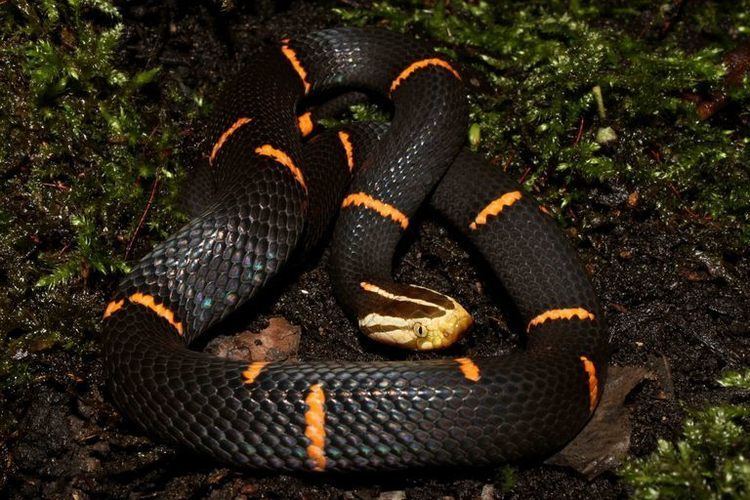Kingdom Animalia Suborder Serpentes Phylum Chordata Rank Subfamily | Subphylum Vertebrata Scientific name Azemiopinae Higher classification Vipers Order Scaled reptiles | |
 | ||
Genus Azemiops
Boulenger, 1888 Similar Snake, Vipers, Reptile, Causinae, Protobothrops | ||
Azemiopinae is the name of a monotypic subfamily created for the genus Azemiops that contains the venomous viper species A. feae and A. kharini. No subspecies are recognized. The first specimen was collected by Italian explorer Leonardo Fea, and was described as a new genus and new species by Boulenger in 1888. Considered to be one of the most primitive vipers, it is found in the mountains of Southeast Asia in China, southeastern Tibet and Vietnam. Its common name is Fea's viper.
Contents
Description
Neither species grows to 1 m in length. According to Liem et al. (1971), the maximum length is 77 cm, while Orlov (1997) described a male and a female measuring 72 cm and 78 cm, respectively.
It is considered to be the most primitive of all viperids for a number of reasons. It has a reasonably sturdy body and a short tail, but the dorsal scales are smooth rather than keeled like those of most vipers. The head, which is slightly flattened and more elliptical in shape than triangular, is not covered with numerous small scales like most other vipers, but with large shields like the colubrids and the elapids. Also, the skull is built differently. It does, however, have a pair of hollow, rotating fangs, although these are short. The fangs have a ridge at the tip lateral to the discharge orifice, as well as a blade-like structure on the ventral surface otherwise seen only in some opistoglyphous and atractaspid snakes. The venom glands are relatively small. Finally, unlike most vipers, Fea's viper is oviparous and hibernates during the winter months.
The color pattern of Fea's viper is striking: dorsally, its basic body color is a shiny, deep blue-gray to black, marked by a number of widely spaced, thin (one or two scales), white-orange crossbands. The head is orange to slightly yellow with a distinct cross-pattern outlined in gray. The eyes are yellowish with vertical pupils. Ventrally, it is olive-gray, with some small lighter spots. The chin and throat are variegated with yellow.
The smooth dorsal scales are arranged in 17 rows at midbody. The anal plate is entire (undivided), but the subcaudals are in two rows (divided). Ventral count is around 180, subcaudals around 40.
Internasals and prefrontals are subequal in length. Their length is between .7 and 1 meters long. The frontal is slightly broader than long, nearly three times as broad as the supraocular. Parietals are as long as their distance from the end of the snout. The loreal scale is small, pentagonal, and as tall as long. Two (or three) preoculars, and two postoculars are present, and two large superposed anterior temporals occur, but only the upper in contact with the postoculars. It has six upper labials, the first and second are smallest, the third enters the eye, and the fourth and fifth are largest. It has seven lower labials, the first is large and forms a suture with its fellow, and the second is small. Ir has one pair of short chin shields.
Geographic range
These snakes range from northern Vietnam through southern China (Fujian, Guangxi, Jiangxi, Guizhou, Sichuan, Yunnan, Zhejiang), southeast, Myanmar and southeast Tibet. The type locality is listed as "Kakhien Hills" (Kachin Hills), Myanmar. The two species are separated by the Red River, with Azemiops kharini to the east and Azemiops feae to the west.
Habitat
Found in mountainous regions at altitudes up to 1000 m, they prefer cooler climates, with an average temperature of 20-25 °C. Sometimes, they are found on roadsides, in straw and grass, in rice fields, and even in and around homes. In Vietnam, their preferred habitat is described as forests of bamboo and tree ferns, with clearings, where the forest floor is covered with rotting vegetation, with plenty of rock outcroppings and many open and subterranean streams. The species is crepuscular, and prefers very moist environments for shelter.
Behavior
This snake has a characteristic threat display. When disturbed, it flattens its body to make itself look wider, and its jaws flare outwards posteriorly, giving the normally ovoid head a triangular shape. Sometimes, it will vibrate its tail. Ultimately, it will strike, during which it may or may not use its fangs. As opposed to Orlov (1997), who stated this species is nocturnal, Zhao et al. (1981) reported it to be crepuscular, active from early March into late November.
Feeding
They apparently feed on small mammals. A captured, immature specimen was found to have eaten a common gray shrew (Crocidura attenuata). In captivity, these snakes are reported to be reluctant feeders, but when they did feed, they took newborn mice, and then only at night. On several occasions when feeding was observed, the prey was not released after being struck.
Venom
The venom profile of Fea's viper is remarkably similar to that of Wagler's viper (Tropidolaemus wagleri). Another study found the enzyme activities in A. feae venom-gland extract are similar to those of viperine venoms, except Azemiops venom has no blood clotting, haemorrhagic, or myolytic activities.
